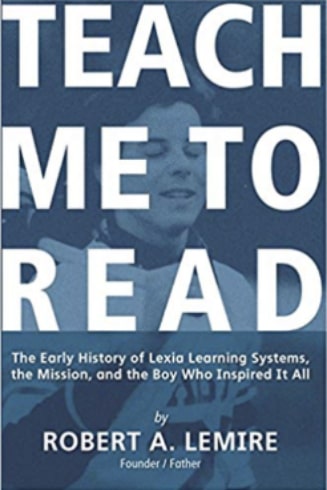The History of Lexia
In 1984, Bob Lemire was a successful investment adviser and devoted father. His journey took a heart-wrenching turn when he discovered his bright, curious son was grappling with reading difficulties. He watched his child’s confidence waver as he soon realized their family was not alone.
A Father's Determination
It was a time when practical resources for dyslexia were scarce, often hidden in obscure scientific journals.
Children, their talents overshadowed by growing frustration, were slipping further behind, with educators offering little support and parents feeling helpless.
But Bob refused to accept this fate. Driven by a father’s love and entrepreneurial skills, he set out to change the landscape for struggling readers everywhere. He founded Lexia®, determined to build the tools and support that didn’t yet exist.
Collaboration & Expertise
Seeking expert guidance, Bob turned to Dr. Edwin Cole, a renowned neurologist and reading specialist. Together with Dr. Littleton Meeks, a technology expert, they recognized the potential of emerging computer technology. This technology had the power to deliver personalized, systematic reading instruction.
This partnership marked the beginning of Lexia’s commitment to the science of reading and Structured Literacy. One family’s need quickly grew into a mission to support all learners.
Today, Lexia is an evolving testament to one parent’s vision and the belief that every child can succeed when given the right support.
What began as a lifeline for students with dyslexia has become a foundational tool for all children learning to read. Lexia serves more than 6.7 million students across more than 23,000 schools nationwide. We continue to lead our field in developing innovative science of reading-based approaches to literacy’s biggest challenges and are committed to leading the change that education needs.

Lexia Timeline: Four Decades of Innovation
1984: A Bold Start
- Bob Lemire founds Lexia to help students with dyslexia become confident readers.
- Launches during the “whole language” era, challenging prevailing trends to champion systematic phonics and multisensory instruction based on Dr. Cole’s research.
- Pioneers the use of early computers for adaptive, personalized reading instruction.
1985: Initial Scientific Validation
- Receives National Institute of Child Health and Human Development (NICHD) grant, establishing scientific credibility.
- Embraces neuroimaging advances to deepen understanding of dyslexia.
- Commits early to evidence-based practices.
1992: Broadening the Mission
- Expands to support all beginning and struggling readers, not just those with dyslexia.
- Recognizes that Structured Literacy benefits every student, especially those from underserved backgrounds.
2000: Science Confirms the Approach
- The National Reading Panel validates Lexia’s core principles: phonemic awareness, systematic phonics, fluency, vocabulary, and comprehension.
- Marks a turning point to recognized evidence-based reading instruction.
2001-2005: Leadership and Growth
- Scarborough’s Reading Rope model supports Lexia’s comprehensive approach.
- Nick Gaehde joins as president, guiding growth amid rising scientific support.
2007: Technology Advances
- Launches Adaptive Blended Learning and Lexia Reading, blending technology with evidence-based instruction.
- Introduces real-time assessment to enhance teaching.
2012-2013: Scaling Up
- Surpasses 1 million student users.
- Introduces Lexia® Core5® Reading for differentiated instruction in grades pre-K–5.
2014: Unifying the Field
- “Structured Literacy” becomes the standard term, aligning with Lexia’s long-standing approach.
2015-2017: Assessment Revolution
- Develops and patents Assessment Without Testing®, providing teachers with immediate, actionable data.
2017-2019: National Spotlight
- Widespread instructional failures are uncovered in reading instruction, beginning a shift away from the “whole language” approach.
- Introduces Lexia® PowerUp Literacy® to help readers in grades 6–12 who struggle to read and those who are nearly proficient become proficient readers and confident learners.
- Lexia earns a “Strong” ESSA rating as demand for evidence-based solutions grows.
2020: Pandemic Acceleration
- Remote learning highlights reading gaps; Lexia’s user base surges to 5 million after Cambium Learning® Group acquisition.
- Introduces Lexia English Language Development™ for grades K–6 to support students’ English language development through academic conversations.
2021-2022: Comprehensive Solutions
- Adds LETRS professional development and integrates Voyager Sopris Learning®.
- The “Sold a Story” podcast marks a turning point in public awareness about the importance of evidence-based reading instruction, reaching millions.
2023: Policy and Momentum
- More than 25 states pass science of reading laws.
- There is a growing recognition that secondary teachers—not just elementary educators—need targeted professional learning in literacy instruction.
- Introduces Lexia Aspire® Professional Learning, grounded in the science of reading. This flexible, self-paced, accredited solution empowers all educators to accelerate literacy skills among students in upper elementary through high school.
- Lexia reaches 6.7 million users, a significant milestone that cements its leadership and the trust it has gained among educators and parents.
2024: 40 Years of Impact
- Celebrates serving nearly 7 million students.
- Lexia is leading the way forward, more committed than ever to making every child a confident reader.
2025
- Lexia launches its most recent solution, Lexia® LETRS® Connect™. This digital professional learning experience provides LETRS graduates with the opportunity to further develop and deepen their understanding of the science of reading while also revisiting their prior LETRS learnings.
